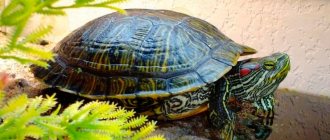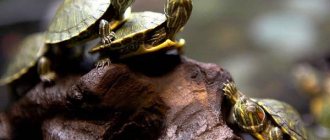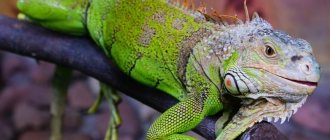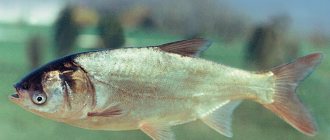Review author: “ZooVita”
Turtles are quite demanding and difficult reptiles to keep. And this applies, first of all, to their diet. Modern pet food manufacturers offer turtle owners a wide variety of “balanced” foods that make caring for their pet much easier.
However, in order to choose the right basic and additional diet and bait, it is necessary to understand in more detail what you can feed the turtle.
Theoretical aspects
Turtles belong to the class of reptiles and, according to their habitat, are divided into land, aquatic: freshwater and marine, semi-aquatic. In addition, according to the method of nutrition, three main groups are distinguished.
Each of these groups is characterized by an optimal ratio of feed of plant and animal origin, which must be taken into account when choosing a diet.
- Carnivores – animal food 70%-90%, plant food 10%-30%. These include almost all aquatic marine species and young freshwater turtles: red-eared, marsh, trionics, etc.;
- Herbivores – plant food up to 95%, animal food no more than 5%. Exclusively land turtles. Of the most popular species kept in captivity, we can note: Greek and Central Asian;
- Omnivores - the ratio of food of plant and animal origin is approximately equal. The same diet includes some types of young semi-aquatic and adult freshwater species, for example, red-legged, red-eared, etc.
How to properly feed a turtle depends not only on the group it belongs to, but also on its species and age. Choosing the wrong type of feed or a significant shift in feed ratio is guaranteed to lead to digestive disorders and metabolic diseases.
What to feed at home?
The diet of domestic turtles depends on their species. At the same time, there is a list of foods that should not be served under any circumstances. Both land and water turtles are not suitable for the meat of domestic or wild poultry - chickens, ducks, geese, game, including boiled, any food that has undergone heat treatment (fried, boiled, stewed, steamed, baked vegetables, fish, meat). The turtle’s body will not be able to digest any prepared food from the human table; it will turn sour in the stomach, the reptile will get sick, and may even die.
Important! The food in the turtle's feeder becomes unfit for consumption after three hours. It is not recommended to leave leftovers until the next feeding.
Experts do not recommend overfeeding your pets with plant foods rich in oxalates: spinach, peas, cabbage. All turtles, except tropical species, should not be treated with citrus fruits, nuts and tomatoes.
Important! When creating a table for your pet, it is necessary to observe the measure. Herbivorous turtles should not be given meat, even for the sake of experiment, and sea turtles should not be fed with vegetation.
What does a sea turtle eat?
The main principle when feeding sea turtles is not to overfeed. As a rule, these are carnivorous animals, so the basis of their diet is protein food.
What do sea turtles eat:
- special food for turtles;
- fish;
- seafood;
- fish food;
- vegetables;
- insects;
- aquarium plants.
A peculiarity of the digestive system of sea turtles is that saliva is not produced in the mouth. They eat all the food they receive or catch in the water. Breeders often transfer feeding animals to another container, and the water in the main aquarium remains clean.
A mandatory supplement in the diet is calcium, without which it is impossible to build a strong shell.
With age, these predators begin to eat more plant foods, and the proportions of their diet change. Protein products should make up only a quarter of the total volume, and 75% should be plant-based “dishes”.
What do river brothers eat?
What to feed a river turtle, what does a swamp turtle eat, how to properly feed a turtle in an aquarium - these questions certainly arise for those who are faced with the need to care for these reptiles for the first time.
Swamp and river turtles are the most common species of aquatic turtles kept at home.
Being predators, aquatic turtles are happy to treat themselves to low-fat fish - live or defrosted; the entrails and bones, especially for young individuals, do not need to be cleaned.
Fish products are given to adult reptiles whole or in pieces, by grinding or finely chopping the bones.
Fish suitable for feeding:
- perch;
- whiting;
- crucian carp;
- cod;
- hake.
Occasionally, turtles can be treated to fatty varieties of fish: sprat, herring, capelin, sprat. Before serving, such fish is soaked in hot water. They love animals and caviar, so you can’t spoil them often.
Seafood options include shrimp, squid, mussels, octopus, and raw scallop. River delicacies include frogs (you should consult a veterinarian about acceptable species), and the tail of crayfish (once a week).
Low-fat meat products - boiled chicken, chicken and beef liver. To preserve the hunter's instinct, turtles are treated to small rodents - naked mice, rat pups. Fatty varieties of beef, pork, lamb are completely excluded from the diet; minced meat, as well as sausages, cat and dog food are not given.
The diet is varied:
- Specialized dry food (pellets, tablets, sticks, flakes, etc.),
- Insects sold in pet stores (bloodworms, grasshoppers, crickets, feed cockroaches),
- Molluscs, invertebrates, amphibians (slugs, small snails with shells, tadpoles).
- Live aquarium fish - guppies, swordtails, goldfish.
You can “season” a meat feast with salad plants (lettuce, dandelion, parsley, dill), beets, carrots, cabbage, pumpkin pulp, and you can also offer apples and pears.
What does a land turtle eat?
It is easier for aquatic turtles, regardless of whether they are sea, river or swamp, to create a menu than their land counterparts. The bulk of land-dwelling reptiles are vegetarians. The diet is formed in such a way that, in addition to taste, it provides the body with useful substances - minerals, vitamins.
Diet of land turtles:
- 80% - greens: leafy greens (salads and edible leaves, including dandelions, carrot and beet tops, herbs, flowers, parsley, dill, succulents, a small amount of onions, sprouted beans, spinach, sorrel, basil.
- 15% - vegetables: cucumbers, zucchini, pumpkin, carrots, bell peppers, tomatoes. Occasionally, in small portions, you can treat radishes, radishes, garlic cloves, cabbage, and beets.
- Less than 5% - unsweetened fruits: apples, pears, apricots, nectarines, peaches, peeled watermelon pulp, peeled orange or grapefruit in small quantities, bananas.
- Supplement once a week - asparagus, mushrooms (including dried russula, boletus and champignons), seaweed, soybean meal, yeast, bran.
Important! Vegetarian land turtles should not be fed fish, meat and dairy products, including fermented milk and cheese, potatoes, various cereals, white and brown bread, pasta, and sweet dates. Cat and dog food is prohibited.
Omnivorous turtles will not refuse dishes suitable for predators and herbivorous species.
What do baby turtles eat?
During childhood, turtles need to satisfy their need for vitamins and microelements that promote healthy growth and development. The cubs need to be fed in a quiet place so that nothing threatens its peace.
The diet will be based on granules or capsules of ready-made food - sold in the appropriate department of pet stores. Such food is well balanced taking into account the type of reptile. Pets are given food every day - preferably in the morning or lunchtime, when they are most active.
A variety of natural food, as well as supplements that will help raise a healthy animal, will not harm small turtles.
For babies, all food is prepared in a special way:
- Dry food is crushed with a knife into small fractions.
- Fruits larger than blueberries should be mashed or cut.
- The food is seasoned with special vitamins and calcium supplements - three times a week.
To ensure that the turtles receive vitamin D, they are given sunbathing under an ultraviolet lamp.
Predatory
The main diet consists of lean fish. As practice shows, the best choice is hake, pollock and cod from sea fish, as well as bream, bleak and perch from freshwater. There is no particular difference or preference between marine and freshwater species.
It is recommended to give your pet liver weekly. It can be either fish, beef or chicken. Young turtles need to cut the fish into small pieces. The spine can be left, but the ribs must be removed.
Adults can eat large pieces, and if the fish is small, then you can feed it whole.
The following food products can be used as additional feed:
- Seafood - octopus tentacles, shelled shrimp cephalothorax, small squid and mussels;
- Liver - including the liver of various animals, chicken or beef heart, as well as live food in the form of baby frogs or mice. It is strictly not recommended to feed turtles with meat, minced meat, sausages, etc.;
- Others (as a rule, given to young animals) - mealworms, food cockroaches, daphnia, snails without shells.
The food given to predatory turtles does not require heat treatment, that is, it must remain raw. First of all, this applies to various additives, for example, shrimp should be gray, not pink.
Principles and procedures of feeding
It is better to feed turtles during their active hours - in the morning, at lunch, or a couple of hours before bedtime. You can tell that your pet is hungry by its behavior - it will actively examine the bottom of the terrarium or aquarium.
General rules for feeding turtles:
- Young animals are fed daily, and adult turtles - 2-3 times a week.
- Turtles should not be left hungry for long periods of time.
- The portion for one feeding is calculated from the volume that the turtle will eat in half an hour.
- You cannot spoil turtles: if she eats something with appetite, this does not mean that the food is beneficial;
- Be sure to give calcium once a week - 100 mg of nutrition per 1 kg of weight (carbonate, ground eggshells, calcium palminate, turtle food, bone meal, sepia).
The transfer of turtles from ready-made store food to natural food and vice versa is done gradually - it will take at least a couple of weeks. If several turtles are adjacent at the same time, during feeding it is necessary to ensure that there is enough food for everyone.
Any species of turtle will be harmed by an excess of the following foods:
- spinach;
- turnip;
- leaf mustard;
- wild cruciferous plants;
- cereals;
- forest mushrooms;
- raw liver or kidneys;
- any nuts.
Land turtles are fed from a feeder, their aquatic counterparts are fed from tweezers, or food is thrown into the aquarium or placed on a bank near the water. The latter method is the most convenient, as it allows you to maintain water quality for a longer period. You should not teach him to eat from his hands - at some point the pet may confuse his fingers with food and bite.
Omnivores
Despite the name, semi-aquatic and marsh turtles are the most demanding in terms of food composition. In addition, their diet can change significantly during the period of growing up.
The optimal composition of the diet depends solely on the type of turtle. In addition, it is necessary to determine how many times to feed small turtles, whose main diet consists of food of animal origin.
Turtle's relationship with drinking water
Aquatic species of turtles do not need additional drink, since they a priori moisten any food with water due to the lack of saliva in the mouth.
Land reptiles have a special relationship with drinking water. The structure of their head does not allow them to fully drink - when water gets into their mouth, it pours out through their nostrils. There are species that never drink at all, content with moisture from food. Others need very little water.
In addition to food, the source of water is also the external environment - moisture enters the body during swimming or baths. Serious dehydration can cause a reptile to drink water. To prevent this from happening, it is important to properly plan your diet, including juicy fruits and vegetables. For example, fresh dandelion and clover leaves consist of 85% water, which will be enough for the reptile’s body.
Experts also recommend giving turtles baths. To do this, once a week I pour a little water into a shallow container and place the pet there. 30 minutes of bathing is enough for him to replenish the existing lack of moisture. Water should not enter the reptile's nostrils.
Photos of turtles
Features of feeding by season
Despite the fact that at home turtles practically do not feel the change of seasons, by winter they become less active. Owners of an exotic pet should remember that it is better not to let it hibernate - it requires special care, and in the spring the animal may not wake up.
As activity decreases, the amount of food consumed also decreases. However, the menu should remain as varied as possible. During this period, seasonal vegetables will be useful for turtles - cabbage, beets, carrots, as well as raw meat and boiled eggs. All products are consumed in moderation.
In addition, calcium supplements continue to be given, and special multivitamins are given to prevent diseases.
If there are doubts about the balance of the home diet, you can switch the animal to ready-made food.
What do turtles eat in the wild?
The main component of the diet of red-eared turtles in the wild are shellfish: mussels and snails, oysters, and crustaceans. They have no teeth, but this does not prevent them from excellently dealing with mollusk shells: with strong jaws they break them and eat the pulp.
In the summer, insects become food for turtles: grasshoppers, beetles, etc.
They are very fond of algae, plankton and small fish. They also eat tadpoles, fish fry and frogs.
Reproduction
In the spring comes marriage time. During this period, turtles (age 6–8 years and shell 9–12 cm) are far from water bodies. Turtles can also mate in water. The sperm of turtles can be stored in the female’s tract for up to 1 year or more; as a result, a female caught in the wild can “personally” lay completely full-fledged eggs after 5-6 months. Between May and July, females lay eggs three times in holes dug in the ground. During the season, the female produces 1–3 clutches. The depth of the pits is approximately 10 cm. The eggs that fall into them are beautiful: their shells are snow-white, they themselves have an oblong, regular shape, size 30 x 20 millimeters, weight approximately 8 g. In any clutch there are about 5–10 eggs, and they The female buries it most carefully. After approximately 2-3 months, these eggs produce tiny turtles about 24–25 millimeters long, weighing 5 g, with a large yolk sac on the belly.
The shell of young turtles is usually dark brown with yellow lines. They dig small tunnels near the nest, where they spend the winter in most cases. In the spring, turtles crawl out of their shelters onto the surface of the earth and begin an independent life. The incubation temperature is about 25–30°C and the duration is 54–90 days. Incubation humidity 90%. The water depth for newly born turtles is approximately 5 cm. Young individuals feed on daphnia and insect larvae.
Description
The low carapace (carapace) is almost oval; if you look at it from above, you can see that the width in the back is slightly wider than in the front. The length of the shell is 20 cm or more in adult large turtles. Since water has always been the key habitat for turtles, the carapace scutes naturally fit perfectly together. In terms of their structure, the carapace and plastron are completely streamlined and have no protrusions. Large claws are located on the legs, small membranes are located between the toes. The claws of a swamp turtle can easily tear prey apart and can significantly scratch your hand.
The tail of this turtle is relatively long, can reach 3/4 of the length of the carapace (about 12 cm) and during swimming it takes part as an auxiliary rudder during any turns (the main steering is carried out by the legs) and as a counterweight that holds the turtle in the required position during maneuvers. The carapace usually has a dark olive, dark green, sometimes almost black color, the plastron is light, yellowish. The shell, neck, head, legs are covered with small light spots. Often females have yellow eyes, while males are slightly reddish. Females have slightly shorter tails than males.
Food in winter
The change of season is reflected in nutrition. In the summer, feed herbivores and omnivores with greens, vegetables and fruits. Turtles eat frequently and have small portions. In cold weather, reptiles are content with frozen foods and hay; they eat rarely, but in large quantities.
You can plant plants in pots, this will provide the turtles with fresh greens to eat in the winter. Propagate plants such as duckweed or hornwort so that turtles can be fed aquarium flora continuously. To do this, you will need to purchase a separate aquarium and properly care for the plants.
Harmful products
Some plants are harmful to reptiles:
- medicinal plants containing alkaloids;
- poisonous plants of the nightshade and buttercup families;
- dieffenbachia;
- elodea;
- spurge;
- azalea;
- hydrangea;
- daffodils;
- ambulia;
- saffron;
- cyclamen;
- digitalis;
- delphinium;
- lily;
- jasmine;
- lupine.
The following products are contraindicated:
- boiled, fried, boiled food;
- sausages, minced meat, pates;
- citrus;
- tops, root crops of radishes, potatoes and radishes;
- avocado;
- eggplant;
- gooseberry;
- parsley;
- cabbage;
- rhubarb;
- berry, fruit seeds;
- porridge;
- dairy products;
- bread;
- food for warm-blooded animals;
- crab sticks;
- tomatoes.
Remember that you should not completely abandon heat treatment of meat. Pour boiling water over meat products to minimize the risk of infecting the turtle with parasites. Feed mixtures containing a lot of fishmeal, dyes and preservatives can also cause harm.
Products available in limited quantities:
- apples;
- corn;
- radish;
- asparagus;
- squid;
- legumes;
- cereal grains, mustard;
- fatty fish and meat;
- pineapples;
- raspberries, strawberries;
- watermelon and melon;
- locusts, crickets, cockroaches;
- onion garlic;
- basil;
- too sweet fruits and berries.
Caring for your turtle
The first thing you should pay attention to when purchasing a pet is its appearance and size. A turtle that is under 5 cm in size at the time of purchase will be very difficult to raise.
At this age, small individuals are susceptible to various infections and diseases. This is how natural selection takes place. Therefore, a turtle 5–7 cm in size will be the best choice when purchasing.
You should also carefully examine the color of the shell. The claws and tail must be intact. The skin looks healthy and the eyes shine. After the pet is in the aquarium, watch how it swims. A healthy turtle should swim smoothly, without leaning in different directions.
Healthy turtle
Features of treatment
After purchasing a pet and moving it into an aquarium, it may go through an adaptation period. Typically it will take 2 to 5 days. At this time, the animal becomes a little inhibited, or, conversely, very active. There is no need to panic and pick up the animal. Give him peace and time to adapt to new conditions. After a while, the turtle will get used to the new environment and become calmer.
When trying to pick up a turtle, do it very carefully and always with both hands. Not all representatives are willing to make contact. Some may flounder, hiss, and defecate in fear. The shell becomes slippery in water; keep this fact in mind when removing your pet from the aquarium.
After you hold the turtle in your hands, be sure to wash them with soap. Despite being kept clean, turtles are often carriers of salmonellosis. To avoid the spread of infection, you must always monitor the condition of the aquarium and the quality of the food.
Major diseases
Of all the diseases found in these animals, the most common is pneumonia. Sea turtles do not tolerate drafts very well and can catch cold easily. When observing the first signs of illness (lethargy, refusal to eat), it is necessary to begin treatment. This should only be done under the guidance of a veterinarian and should not be self-medicated under any circumstances. An experienced specialist will correctly prescribe medication treatment. In addition to this course, you can prepare a steam bath with chamomile infusion for your turtle. The steam should be at such a temperature that it does not burn your hand. After holding the animal over the steam for a while, then place it for an hour in a warm bath, one-third consisting of chamomile decoction.
Discharge from the eyes, swelling of the eyelids, soft shell - all this is a serious reason to contact a veterinary hospital.
If you decide to have such an unusual pet at home, you should keep in mind that under favorable conditions, a turtle can live up to 35–40 years.
Ready-made feed
With a constant lack of time in the modern world, people are forced to buy ready-made food for their pets. Sometimes this method also saves effort - you don’t need to prepare the mixture yourself. Below are the main types of commercial turtle food.
Overview of store options
Arcadia Herbi mix
The food is based on plant components with the addition of pollen. It is rich in mineral and vitamin supplements. Suitable only for land turtles.
Sera Raffy Vital
The food is intended for omnivorous turtles. Contains grain (wheat and oats), dried vegetables, fish and its processed products. Enriched with vitamins A, D and B.
Zoomir Tortila granules
The food is suitable mainly for omnivorous mature turtles. Ingredients: alfalfa, vetch, dandelion, berries, carrots, small crustaceans.
Zomir Tortila Fito
The composition includes alfalfa, vetch, dandelion, nettle, cereal seeds, apples, carrots, lingonberry leaves, and a vitamin and mineral complex. Suitable for herbivorous species.
There are almost no prepared foods for carnivorous turtles, since the animals need fresh food and not processed products (for example, fishmeal). The owners of these animals are strongly recommended to feed the reptiles fresh, chilled fish.
DIY food
Herbivorous turtles, like carnivorous ones, rarely have their food prepared. In the first case, it is enough to simply cut the vegetables and put greens in the feeder; in the second, chop the fish and seafood. Therefore, omnivorous aquatic turtles most often need prepared food.
The universal recipe includes:
- cabbage – 50 grams;
- carrots – 70 grams;
- apples – 50 grams;
- squid fillet – 100 grams;
- any lean fish – 145 grams.
All components must be mixed, passed through a meat grinder and a gelatin solution (10 grams per 50 milliliters of water) added. The cooled mixture must be dripped with a mineral additive in the amount specified in the instructions. Cut the resulting “jellied meat” into small cubes.
This recipe is suitable for a small omnivorous turtle - with a shell about 15 centimeters in diameter. The red-eared turtle will especially appreciate this recipe.










